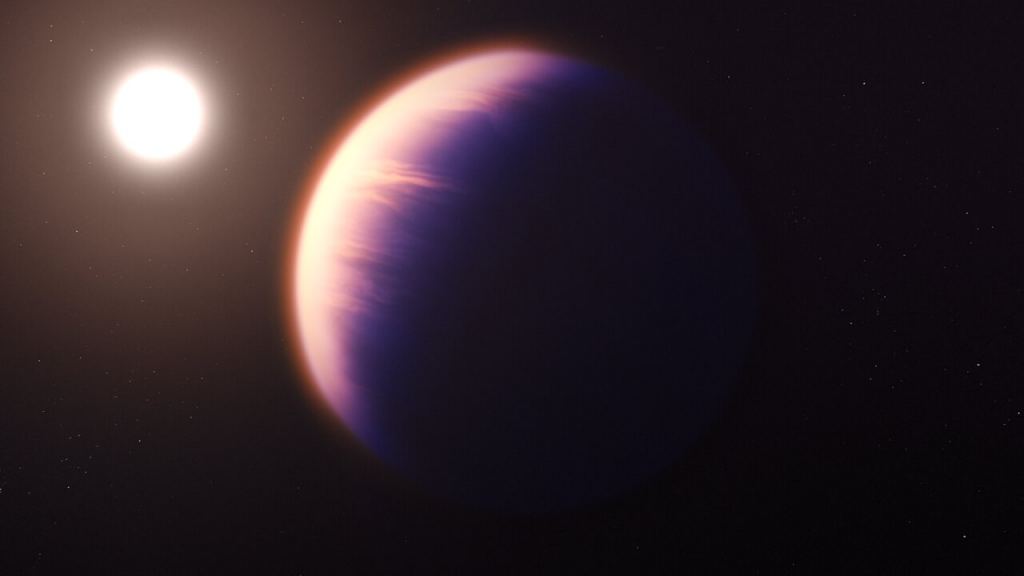NASA’s JWST data just keeps on delivering amazing discoveries. Back in July, it observed the exoplanet WASP-39 b and found fingerprints of atoms and molecules and active chemical reactions in its clouds. Now, a team of scientists extends that discovery with a much deeper analysis of the data.
According to Dr. Natalie Batalha, from the University of California-Santa Cruz, the JWST data are a game changer. “We observed the exoplanet with multiple instruments that, together, provide a broad swath of the infrared spectrum and a panoply of chemical fingerprints inaccessible until [this mission],” she said.
The July observations were pretty exciting. JWST’s Near Infrared Spectrograph (NIRSpec) instrument recorded the first unambiguous evidence of carbon dioxide (CO2) in an exoplanet atmosphere. It also made the first detection in an exoplanet atmosphere of sulfur dioxide (SO2, which is a component of smog here on Earth).
SO2 is produced by chemical reactions triggered by high-energy light from the planet’s star. On Earth, the protective ozone layer in the upper atmosphere is created in a similar way. The next step was to do a coordinated analysis of all the NIRSpec data.
The results released this week give a much clearer and richer understanding of the planet’s thick atmosphere. How JWST Got the WASP-39 b Data WASP-39b is not exactly an Earth-like planet. Instead, it’s a gas giant world with a mass about the same as Saturn’s.
It lies closer (0. 0486 AU) from its G-type star than Mercury does to our Sun, and orbits once every four Earth days. The planet turns out to be quite a puffy world, largely because it’s hot (about 871 C or 1600 F).
We know most of this from prior observations made by Hubble and Kepler Space Telescopes. A transmission spectrum of the hot gas giant exoplanet WASP-39 b captured by Webb’s Near-Infrared Spectrograph (NIRSpec) on July 10, 2022, reveals the first clear evidence for carbon dioxide in a planet outside the solar system. This is also the first detailed exoplanet transmission spectrum ever captured that covers wavelengths between 3 and 5.
5 microns. JWST tracked the planet as it passed in front of its star. Starlight filtered through the atmosphere and different gases there absorbed different colors of the starlight spectrum.
This is how NIRSpec detected water, sulfur dioxide, carbon monoxide, sodium, and potassium at WASP-39 b. It also provided data about CO2 at a very high resolution. Finally, the instrument revealed active chemistry in the clouds, which appear to be broken and scattered, instead of blanketing the planet in one monolithic layer.
What The Atmosphere Tells Us Now that astronomers have a good inventory of chemical elements at WASP-39 b, they also see how abundant each chemical is in its atmosphere. That’s precious information. Among other things, it gives clues to conditions in the disk where the planet, its star, and any other planets, formed.
In fact, the gases in WASP-39 b’s atmosphere provide hints about a history of smashups and mergers. “The abundance of sulfur [relative to] hydrogen indicated that the planet presumably experienced significant accretion of planetesimals that can deliver [these ingredients] to the atmosphere,” said Kazumasa Ohno, a UC Santa Cruz exoplanet researcher who worked on NIRSpec measurements. “The data also indicate that the oxygen is a lot more abundant than the carbon in the atmosphere.
This potentially indicates that WASP-39 b originally formed far away from the central star. ” WASP-39b Results Hit the Presses The survey of atmospheric chemistry that JWST performed is the subject of five scientific papers in review and publication. They contain some pretty amazing revelations.
“This is the first time we see concrete evidence of photochemistry—chemical reactions initiated by energetic stellar light—on exoplanets,” said Shang-Min Tsai, a researcher at the University of Oxford in the United Kingdom and lead author of one of the upcoming papers. “I see this as a really promising outlook for advancing our understanding of exoplanet atmospheres with [this mission]. ” The precision with which NIRSpec could detect so many atmospheric signatures bodes well for future exoplanet studies.
This is particularly true as astronomers hunt for planets where life might exist. Their atmospheres will contain chemical clues that point to that life. “We are going to be able to see the big picture of exoplanet atmospheres,” said Laura Flagg, a researcher at Cornell University and a member of the international team.
“It is incredibly exciting to know that everything is going to be rewritten. That is one of the best parts of being a scientist. ” NASA’s Webb Reveals an Exoplanet Atmosphere as Never Seen Before (includes links to science papers)WASP-39b The post JWST Detects Signs of Active Chemistry and Clouds in the Atmosphere of Exoplanet WASP-39 b appeared first on Universe Today.
.
From: universetoday
URL: https://www.universetoday.com/158761/jwst-detects-signs-of-active-chemistry-and-clouds-in-the-atmosphere-of-exoplanet-wasp-39-b/



